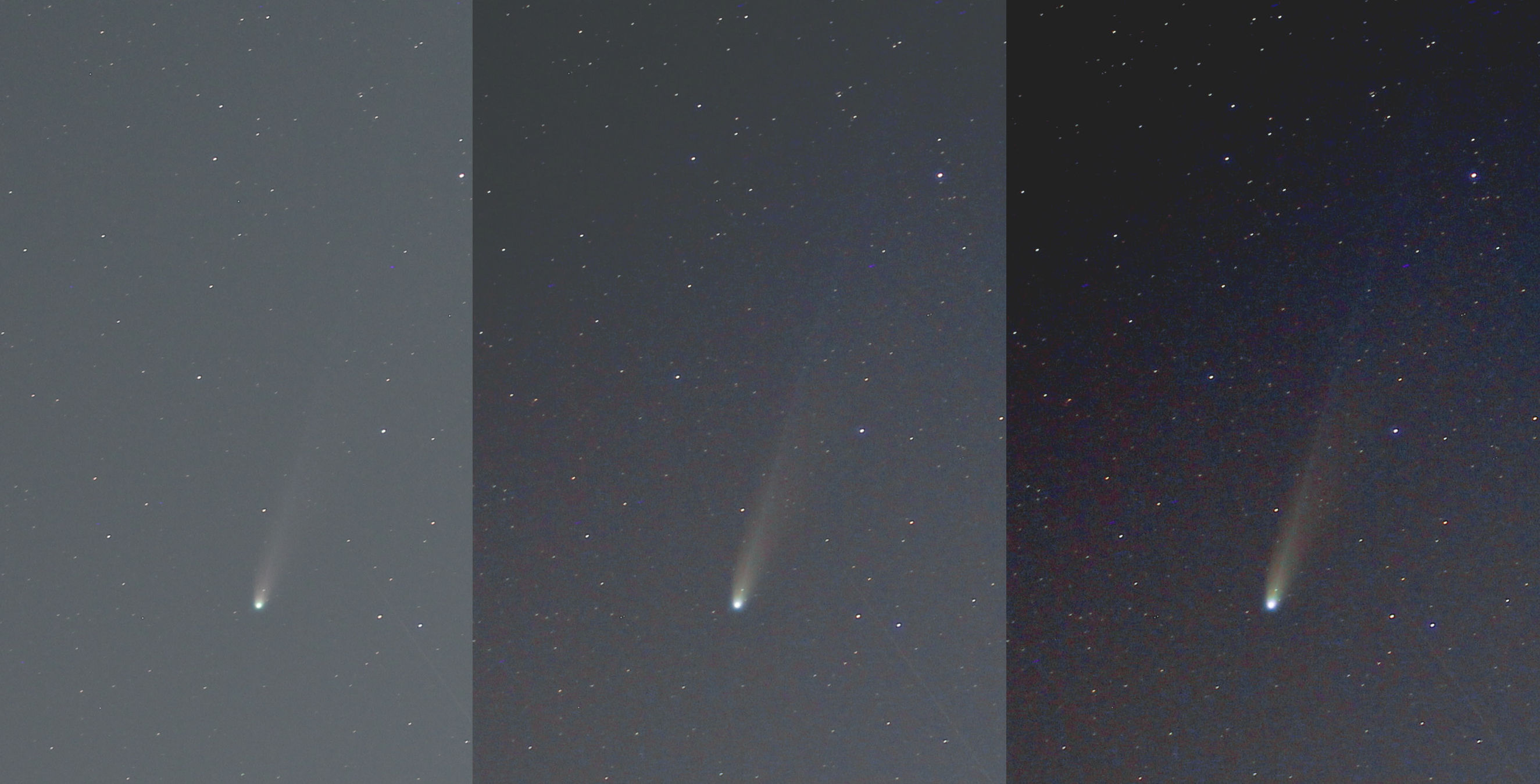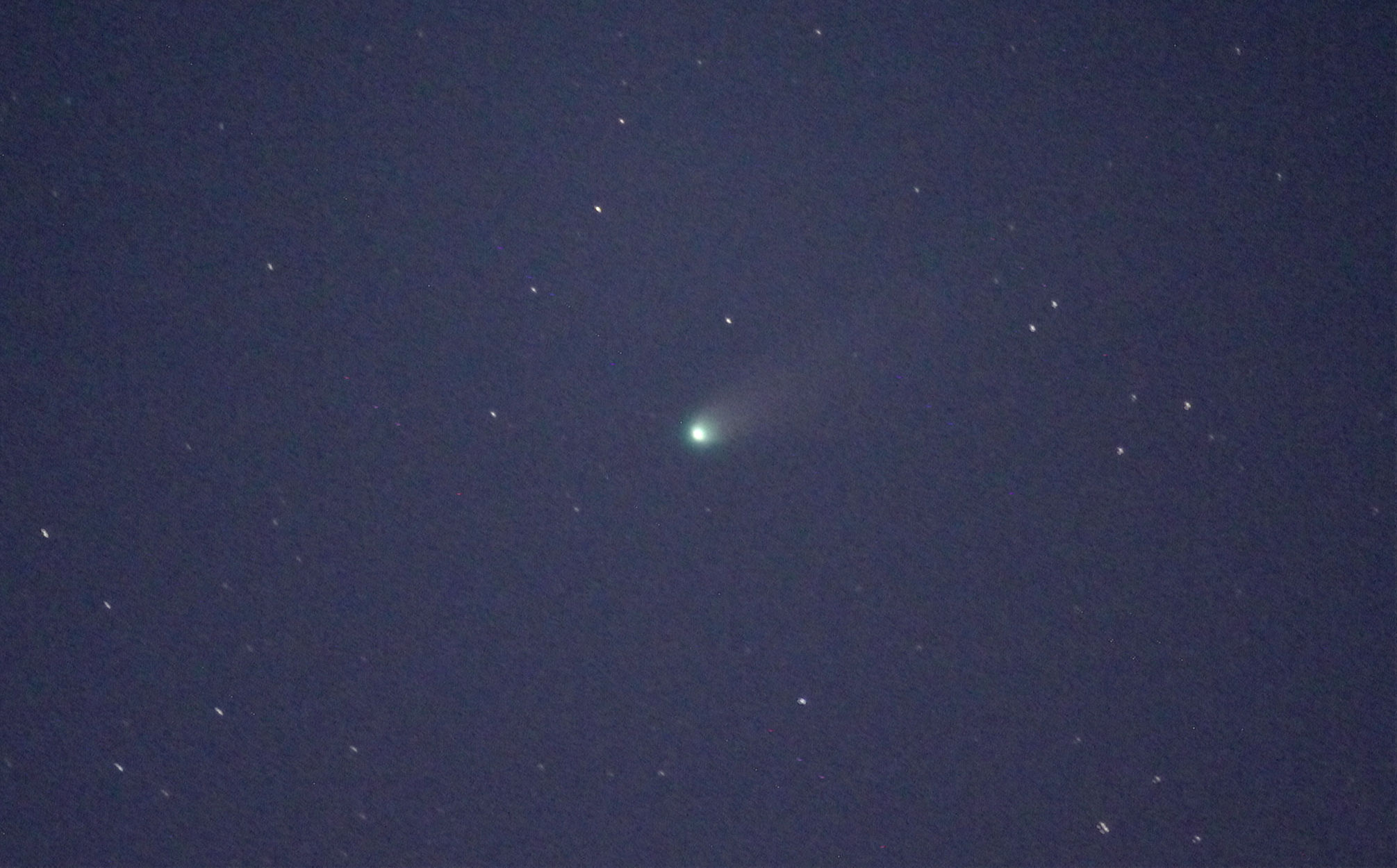Karl's Astro-Journal
"The universe is like a safe to which there is a combination, but the combination is locked up in the safe." -- Peter de Vries, novelist
October 27, 2025 Sunset brought with it two unexpected occurrences, namely: 1) a rare, clear and calm late October evening in Upstate, NY and, 2) a surprising and seemingly miraculous burst of motivation to get outside and try to image Comet Lemmon one more time. From MacArthur Park, a city park not far from the center of town, the comet was a bit brighter than last outing and was fairly easy to spot with binoculars and then zoom in with the camera.
Obstacles to imaging included city sky-glow, park lights, residual twilight, a glowing crescent Moon, and the now ever present streaks of Starlink satellites crossing nearly every exposure. Even so, it was a nice evening with a few curious pedestrians stopping by to see what I was up to. The image shown here is the same picture of the comet with increasing attempts to eek out a little more detail with the image on the left showing the comet unprocessed out of the camera. Astro-imaging processing can get very elaborate but nothing more here than some adjustments to the brightness, contrast and an attempt to subtract out some of the greenish-gray sky-glow produced by city lights. Still, perhaps a better result than my last comet Lemmon outing. And now, once again, Farewell Comet Lemmon.
October 16, 2025:
Comet C/2023 A6 (Lemmon) is now an evening object in New York skies and was visible even from a local city park here in Binghamton. I had no immediate plans to try and photograph the comet since it's still several days from its closest approach to Earth on October 21st and is expected to brighten to perhaps magnitude 3.5 from is currently faint magnitude of 4.5. But, the 10 day weather forecast changed my mind as the sunny part of the great autumn weather we've been having looks like it's about to come to an end. Nothing but clouds and rain in the forecast for at least the next 10 days. This transition to endless clouds is typical for NY as winter approaches and was motivation enough to grab a camera and head to the park.
It was a cool and breezy evening near 50
oF (10
oC). A sweatshirt was enough to basically stay warm but I was glad to have placed some of those hand warmer packets in my sweatshirt pockets. Good idea! Fingers, toes and ears are the first to get cold when all you're doing is standing around pushing the shutter button. As amateur astronomers often quip, "Amateur Astronomy is the one area of science where I'm truly
out-standing in my field."
Comet Lemmon is a small comet compared to the dozen or so I've seen over the years and it took a while to find it in the fading evening sky. Photographing a faint-anything in the sky at dusk, near the horizon and with city lights leaking into the darkening twilight, can make for a challenging photography endeavor. The main problem is insufficient contrast to eek out some details of a faint object like a comet. But, modern image-editing software can help. The photo shown here is an average of two of the best pictures from the evening with the contrast and color-saturation increased using Paint-Shop-Pro. It's not what I would call a great (or even good) photo but it was a nice evening and for me it was enough. I'm happy to bid a fond farewell to Comet Lemmon.
September 02, 2025:
A strong but short-lived blast of solar stuff collided with Earth's magnetic field and atmosphere last night sparking the appearance of the Aurora Borealis across many northern states.
Unfortunately, they did not appear here in NY's Southern Tier.
I drove out to Whitney Point Lake to try and photograph the light show but clouds, ground lights, and perhaps my own lack of patience left me holding an empty bag of aurora photographs.
The geomagnetic K-P Index topped out at 6 which is usually not quite strong enough to create aurora visible this far south unless conditions are just right, ie. no clouds, no Moon, low humidity and an Interplanetary Magnetic Field B
z that's pointing strongly to the south.
Still, it was a very nice evening under the stars for a few an hours.
The Sun remains very active and with any luck I'll have another chance to try and capture some photos of the Northern Lights this Autumn.
May 27, 2025:
High clouds were the weather of the day today. From a south facing window I caught a glimpse of a Sun-halo and then noticed a second arc of light closer to the horizen. Sun-halos are mostly white to the unaided eye and to the camera as well. But by increasing the color saturation with the help of Paint-Shop-Pro image editing software, the faint rainbow colors of the arcs can be nudged out of hiding.
(Note to self: Insert long winded explanation of how Sun-halos form. Ah, ... nevermind. Just go check it out on Wiki.)
The most interesting Sun-halo I recall was on a trip to southern California. On that trip we enjoyed Pacific ocean views near Carlsbad, looking for seals on the beaches below the cliffs of
Torrey Pines State Natural Reserve, a boat ride out to
Catalina Island, and of course, a ride up to the famous observatory atop
Mount Palomar. Visiting the historic observatory was a wish-list item of mine for many years since I was raised when Mount Palomar was the largest optical observatory in the world. The day of our ride up the windy road to the observatory was similar to today and a vivid Sun-halo made a fitting background to the observatory dome. (can't for the life of me find the picture I took of that.)
Comments concerning this Web Site can be sent to: Webmaster. Copyright © 2025. All rights reserved.
Link01 Link02



